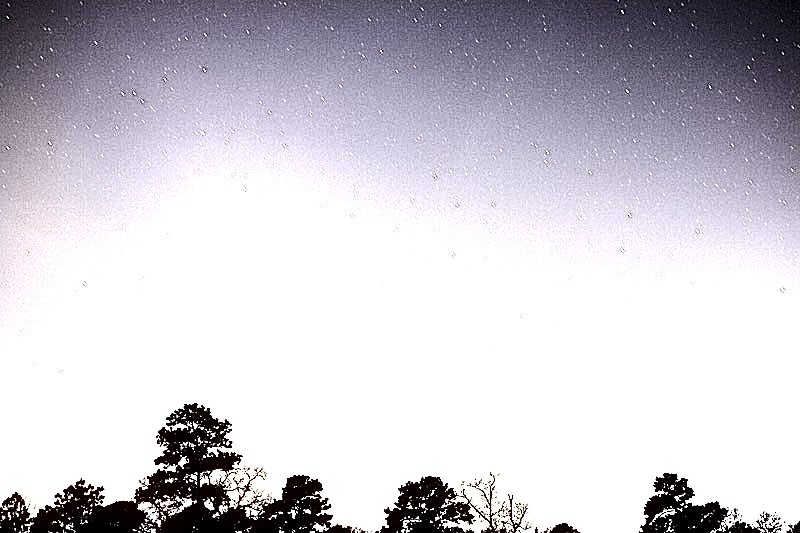
Inspired by others in the Northern Hemisphere who were able to capture some of Comet McNaught's tail on the night of the 1/20/2007, (See Dean Ketelsen's notes and links to images at bottom of this page), I gave it a go on 1/21/2007 from The Woodlands, just north of Houston, TX, USA. (The main part of the comet was only visible from the southern hemisphere by this time.)
This image from Terry Lovejoy shows just how huge the tail was at it's peak. Terry writes: "Its interesting looking at your images and Deans seeing that there were sections of tail not visible from the southern hemisphere at my latitude of 28 south even on January 21 when my own observations traced the tail 50 degrees from the nucleus (but because the tail was so curved the real length was at least 60 degrees)."
The synchrones ("synchronic bands") are the "rays" in the comet's tail. They are so big and bright that they were visible from the northern hemisphere, in spite of the waxing crescent moon. If I read this right, the moon was 43 degrees away from the comet when these pictures were taken.
Update: HAS club member and comet guru Don Pearce processed my image (the bottom one) to better show the comet: "I have taken your image and enhanced it with some editing software. One can clearly see the striation (we, apparently, need to drop the term "synchrones") emanating from the right-center of the image towards the top at about an angle of around 20 degrees from straight up. There is another very obvious one on the left side of the image at about the same angle. And there appears to be some (maybe 2 or 3) fainter ones in between. All the overexposed stuff from the Moon on down are clouds. Feel free to post these, if you want. Thanks,....Don Pearce ... and then, on what to call those things: I have too, actually, there seems to be some confusion, some very vocal folks are calling them "striae" , while I just uncovered an article by Sekanina, who referred to them as "synchrones." I think the problem with using the term synchrones is that, by most definitions, refers to an event where "all the particles leave the comet at a given instant". I am sure this refers to one synchrone, and I honestly don't know if this fits. Stay tuned, in the meantime call them anything you want. "

After seeing HAS club member Kenneth Drake's successful image, I was able to find one example showing the synchrones in my take for the night. See in Kenneth's image below there are faint bands radiating generally upwards to the right and left. Note the orientation of the ray going to the upper right of the moon.
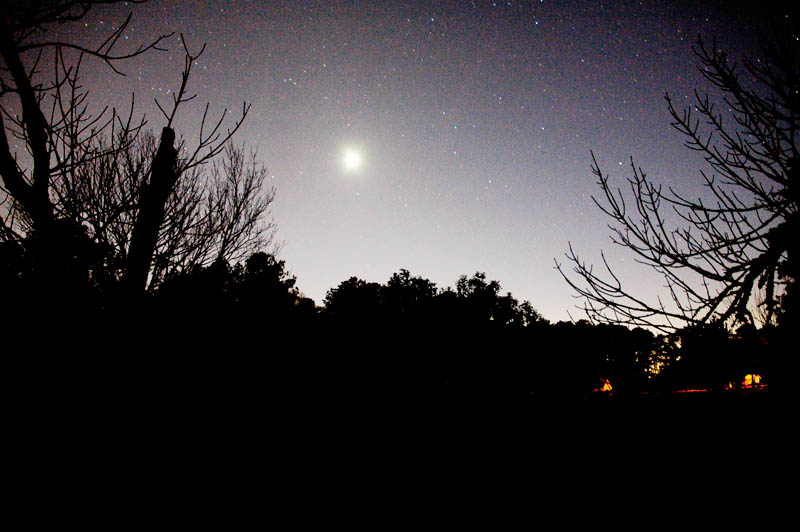
Kenneth Drake's Synchrones (above)
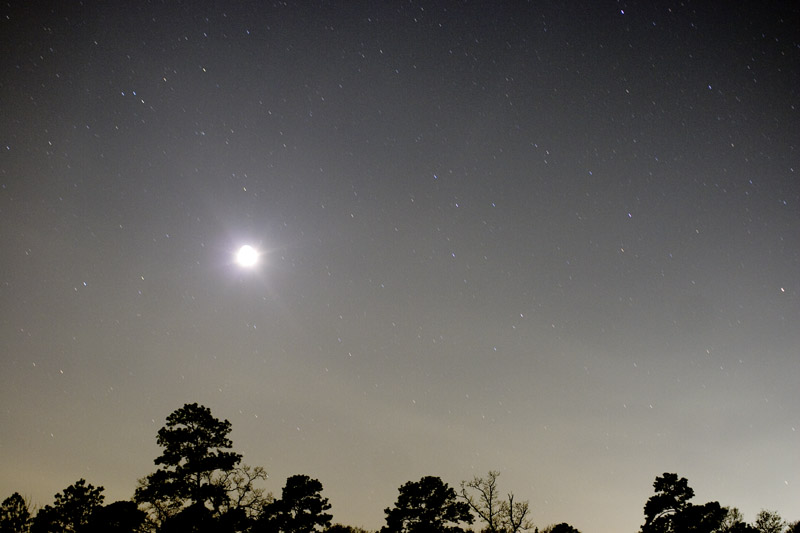
Dick Locke's Synchrone(s)
The easiest band to see on my shot is to the right, between 55 Zeta1 Aquarii on the bottom and 62 Eta Aquarii. Just above the moon there's an upside-down triangle of stars. The upper left "star" is Uranus shining at mag 5.92 according to "The Sky." There's the faintest hint of a band on the left, also.
My Shot was with a Canon 20Da DSLR, with a 35 mm f2.8 Canon lens at f2.8 for 30 seconds, ISO 800. Time was 7:00 p.m. central time plus or minus a few minutes. I did not capture any usable flat frames this night, so for now I'm stuck with this vignetted version.
Quoth Mr. Drako: I made an attempt to get shots on the only clear evening, Sunday. To my surprise, I also recorded several vertical tilted slightly right thin bands bracketing the Moon. Reminds me of "Mule's Ear Peak" in Big Bend National Park. They had dinural motion in the 6 images I took. I moved the camera after the 1st three shots to use a tree to block the moonlight. The bands (comet tail) remain fixed relative to the star field. Now I need to spend some time enhancing them. Kenneth's shot: Nikon D70, 18-70mm lens at 18mm, 30 sec at f3.5, ISO 1600, almost exactly same time as my image (7:00 p.m).
Below: This was the first time in a long while that we saw blue sky. Here's couple nice shots of the crescent moon (11% illuminated) and Venus (lower right, shining brightly at nearly mag. -4!)
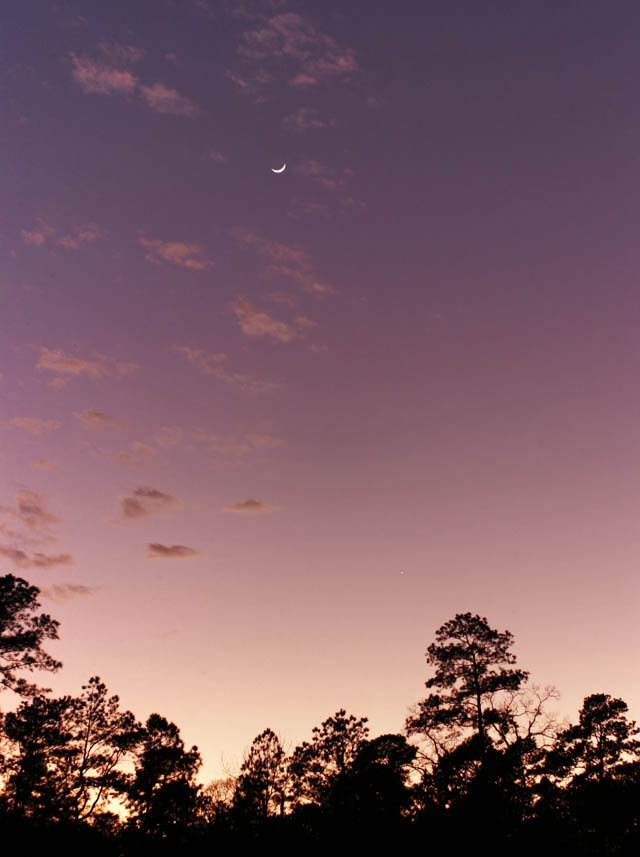
Venus and the Crescent Moon (Canon/35mm lens as above)
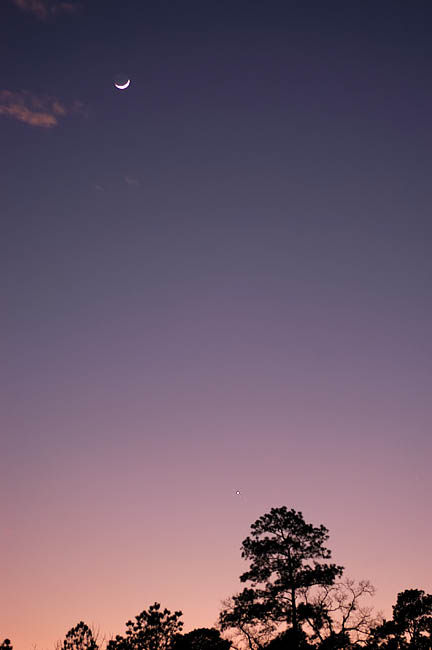
One more Moon & Venus (Nikon D100, 55 mm f2.8 lens)
Hi All- With the waxing moon, and rumors that the synchronic bands might still be around, I headed west from an overcast Tucson in search of sucker holes. I got out to Kitt Peak National Observatory under a gap in cloud banks. The Observatory had a fog shroud on top, so I stayed at the turnoff from the main highway and set up the G-11 with the Canon 20Da, so I wouldn't have to worry about guiding. The bands popped out even before the end of twilight, and I shot with a couple lenses with the little time available. First was with a Nikon 16mm fisheye. This is 60 seconds (all subsequent shots are 60s @ F/2.8): http://alice.as.arizona.edu/~ketelsen/McNaught16mm60sSM.jpg I moved to a Nikon 50mm. This is a stack of 2 exposures, so 2 minutes total exposure. There were thin clouds around... http://alice.as.arizona.edu/~ketelsen/McNaught50mmAve2X60sSM.jpg I then wanted a wider view, so went for the Nikon 20mm for what turned into a sequence as the clouds moved in. Here is the first one: http://alice.as.arizona.edu/~ketelsen/Mcnaught20mm60sSM.jpg The clouds quickly moved in, though clear spots came thru once in a while, so I made a GIF out of the frames - 2 of them include a DPS helicopter... 60 second exposures every 150 seconds... http://alice.as.arizona.edu/~ketelsen/McNaughtSynchones.gif The bands made a much better impression than Jerry implied. The two brightest ones (left central and right) were readily visible, and with averted vision, they were all visible as an enhancement of the zodiacal light. They didn't take magnification well - the binocular view was just lumps of straited glows - no details visible... Anyway, I'm glad I made the effort to get out of town! Assuming they are in the same position tonight, the brightening moon will be smack amoung them! -Dean
Actually, since those were taken last saturday night, I went out again on tuesday night, the 23rd (24th U.T.) on the western slopes of Kitt Peak National Observatory. What a spectacular night, even with the moon out - I thought I could occasionally spot M33 even though it was only about 30 degrees from the moon! Mercury was spotted too during twilight and visible for nearly 20 minutes. So anyway, with the moonlight, I wasn't able to expose as long as last weekend when I easily caught the bands. I took a series of exposures, varying somewhat between 30 seconds and a minute. There ended up being 17 exposures and they are stacked into: http://alice.as.arizona.edu/~ketelsen/23Jan16mm17X40sSM.jpg I pretty sure all the streaks that are not coming out of the moon are synchronic bands from McNaught. In an attempt to see if there were any farther north, I moved to a 20mm lens and aligned the format N-S. This is a stack of 3X60 seconds (all shots at F/2.8, and ISO was on 800): http://alice.as.arizona.edu/~ketelsen/23Jan20mm3X1mSM.jpg I tried using a mask to keep the moonlight out of the camera, but I don't think this shot shows anything more than with the 16 fisheye. But note how bright the zodiacal light was, and even the North American Nebula is visible in the 3 minute exposure. I haven't seen any detections of the bands any later than this and with the brightening moon, it might well be impossible. Thanks for asking and good luck with your observing! -Dean
This is a tale of a bright comet whose original elusiveness made it difficult to observe, and how it sneaked up on most of the astronomical community. To understand why, we have to trace its history back even before its discovery. Long before recorded history, perhaps several million years ago a comet was nudged out of the Oort Cloud, and began its long journey towards the inner solar system. It was approaching from well below, "south" of the ecliptic, and at a very steep angle so that it was coming from almost straight “down”, being inclined over 77° to the ecliptical plane. On about May 29th of 2006 it finally reached its ascending node, while perhaps about 18-19th magnitude, and still almost 4 A.U. from the Sun. At that time it wasn't too far from being at opposition from the Earth and its orbital speed was about 21 kilometers/second. Then, on Aug. 7th, 2006 Ron McNaught discovered it on images from the .5-meter Uppsala Schmidt telescope at Siding Spring in Australia, while still at mag. 17.3, and about 3 A.U. from the Sun. It was located in Ophiuchus and given a name, Comet C/2006 P1 (McNaught). The preliminary orbital elements were way off and gave a q (perihelion distance) value of 1.55, but by the end of August a good orbital determination had been made and gave a q of .17 A.U. At this point, comet watchers became aware that this comet had the potential to either become very bright and/or develop a significant tail around time of perihelion.
However, there were two problems, one natural and one due to human error. First let us discuss the natural, which turned out being a problem of geometrical perspective. After reaching its ascending node Comet McNaught began to climb, gaining speed as it raced toward the Sun. By December 8th it reached its maximum height (.4 A.U. above the plane of the ecliptic), but by this time the Earth was on the other side of the Sun, so that the comet was approaching from the same direction as the Sun’s location. At this time the solar elongation had closed to about 14.4°, and the prospects for observing it would only be good if the comet were to become very bright. The comet reached its maximum solar altitude of 84° on Jan. 8th, 2007, in other words it was almost directly above the Sun on that day. The reason this did not occur near Dec. 8th was the same reason that an airplane flying towards you from the horizon would appear lower than when it is directly overhead. After Jan. 8th, the comet continued plummeting south very rapidly, and on Jan.12th it reached perihelion at .1707 A.U. and its orbital speed increased to its maximum of 102 kilometers/second (228,000 mph) The elongation further decreased until it reached a minimum of 5.4° on Jan. 13th, one day later. It also reached its descending node on the 13th and started becoming more favorably placed for southern hemispheric observers, except for one important factor, which I will explain a little later. On Jan. 15th the comet reached its closest approach to the Earth, (.8179 A.U.) only 3 days after perihelion. So we had the very fortunate confluence of perihelion and perigee occurring at about the same time. To summarize why this comet’s orbital geometry made it so difficult to observe, as it brightened approaching the Sun, it was approaching (from our perspective) from behind and over the Sun, never exceeding a solar elongation of about 16° since Dec. 1st. What all of this meant was that the comet, when at its brightest, would not likely be observed in a dark sky.
All of the information discussed in the previous paragraph was known from the end of August. What was not known, as has become apparent, was its intrinsic brightness. The IAU assigned an absolute magnitude value of 10 and an n value of 4 (inverse 4th power) for the brightening parameter. (usually displayed as10 in software for brightening factor, i.e. 2.5x 4) It should have become apparent at least by November 1st that these values were seriously in error, for it was running about 2.5 magnitudes brighter then and about 3 magnitudes brighter by the 1st of Dec. However, there are other considerations. Once it was suspected that this comet was making its initial trip from the Oort Cloud, I am sure that red flags went up at the IAU in terms of the fear of overestimating a “virgin’s” magnitude. With the experience with Kohoutek and Austin, to name two comets, and the very real possibility that an original Oort visitor would have surface volatiles that could, initially, sublimate at a rate that would indicate the comet is brighter than it would turn out to be, I am sure that caution was utilized. Whatever the reason, the 10 absolute magnitude value was ultimately found to be about 5 magnitudes (100 times) too faint. Just recently, the IAU changed it to 6, but I believe 4.7 is a better fit. Even this value would not yield the results that were ultimately observed. For whatever reason, I had a gut feeling that this comet could become spectacular, and announced at the December Houston Astronomical Society meeting (Dec.1st) that it might become either very bright and/or develop a long tail. Earlier I mentioned the fact that after Jan. 8th, it began passing in front of the Sun, meaning that it was now crossing between the Sun and the Earth. This would produce an effect known as forward-scattering of sunlight by the comet’s dust grains. The amount of forward-scattering would be dependent on the scattering angle (the smaller that angle the greater the magnitude enhancement). According to one study (J. Marcus) on about Jan. 14th the comet’s magnitude increase would be at a maximum of about 2.3 magnitudes from forward-scattering, yielding a total magnitude of –5.2 for the comet’s total magnitude. This is almost exactly the observed value on that date, and about the brightest that the comet ultimately attained.
That, of course would make this comet the brightest since Ikeya-Seki in 1965. But let us return to the comet’s elusiveness. During most of Dec. of 2006 the comet eluded observers, however, the comet was imaged using CCDs. Finally, towards the end of the month, traditional images and scattered observations began coming in. However, due to its proximity to the Sun and its still relative faintness, there was disagreement as to how bright it was. It was also late in Dec. before the forward-scattering concept began to be seriously discussed. In early Jan. more images and observations began pouring in from northern latitudes. Then, on the first weekend of January, “all hell broke loose”, astounding reports and images began coming in like a flood, still mostly from the northern latitudes. From the Houston, Texas area I attempted on Friday and Sat. (Jan. 5th & 6th) to observe McNaught, under clear skies, but to no avail. Then on Monday Jan. 8th, at 10 minutes after sunset I saw McNaught for the first time in binos. I knew, immediately, that it was the brightest comet I had ever seen. To see a comet in bright civil twilight, only 5° from the horizon and only about 13° from the Sun was a startling experience. I estimated its magnitude at –2.0. It also had an obvious narrow fan tail about one half degree long. I also observed it on the next two nights under poorer conditions, and on Wed. the 10th I was again startled to see McNaught, this time through murky skies, and still shining like a beacon through tree limbs less than one degree from the horizon. This time I estimated its magnitude at –3.9, about as bright as Venus. Unfortunately for observers in southeast Texas, the veil came down at this point. Although there was some sunshine on Friday, the 12th, perihelion day, there were still too many clouds around the Sun for me to be able to see the comet. I did not seen the Sun (and obviously not the comet) at all through Jan. 17th. Meanwhile, all over the world observers were seeing the comet naked eye, it seems that the most reliable maximum magnitude estimates reached were about - 5.2, more than 6 times brighter than Venus. Amazing images were also taken with the NASA SECCHI HI-1B instrument and the SOHO LASCO C3 camera. Observed tail lengths varied for several reasons. The perspective was not that good around perihelion, and observed tail lengths were also hampered by observations being made during broad daylight to during bright civil twilight and close to the horizon. Generally, reported tail lengths did not exceed much more than a degree with the exception of some observations made earlier in Jan. from northern latitudes. Of course, as its elongation grows and the perspective improves southern hemisphere observers will undoubtedly see longer tails. As a side note, McNaught currently has a hyperbolic orbit and will likely escape the solar system altogether in the distant future. It has spent only a little over 7 months above the ecliptic during its entire span of existence.
Was McNaught a great comet? For us in the northern hemisphere, if your definition requires a “great comet” to be seen in a dark sky with a long flowing tail, then the answer may be no. Undoubtedly, observers from the southern hemisphere will see extensive tail structure. But I would submit that McNaught is indeed a truly great comet because of its astounding brightness, the like of which we may not experience again for a long time…….Don Pearce (end of part 1)
(Synchrones, Syndynes, or Striae)
After Comet McNaught passed perihelion on Jan.12th and its descending node on Jan.13th, the coma continued to be observed in the northern hemisphere only because it was still so bright it could be seen in broad daylight. This would last for almost another week, and then, if this had been a “normal” comet, would have been forever lost for northern observers. But something startling and fantastic occurred on around Jan. 18th. The first picture I saw was taken by Graham Palmer from New Zealand, (taken Jan.18th) and I was totally astounded by its appearance. While not showing the “streaks” (my very first impression) as well as some other later images, it clearly showed me something I had never witnessed before in a comet. I remember thinking to myself, because the human brain tends to operate within a known zone, that maybe this was some kind of crazy weather phenomenon. The flood of incoming images, however, only intensified the reality of what this comet was displaying, a truly wondrous gift of nature. By Jan. 22nd the tail had reached its maximum length of an estimated 80-90 degrees (counting its extension into the northern hemisphere), although most southern hemisphere observers were only reporting about a maximum 30-degree tail. It also displayed a maximum width of about 30 degrees. Overall tail length was perhaps in excess of 150 million kilometers (about 1 AU). But as large as this comet was, it wasn’t its size that really made it so amazing. It was the incredible structure of the tail that very few people had ever witnessed. To make it even more incredible observers from the northern hemisphere, while well out of observational range of the head of the comet, were seeing these bands even up to 45 degrees north. Two of our members, Kenneth Drake and Dick Locke were even able to image them. These bands, which immediately began to be referred to as “synchronic bands”, also presented a real challenge for me. I stared at my monitor and wondered what mechanism could have produced this. I suspected, due to the even spacing that, it had to involve the rotation of the nucleus, with the probability that some “hot spot” (or vent) was releasing material in rhythm with its rotational period. I researched a 1976 article by Zdenek Sekanina, then I consulted with some cometary experts. Finally I came up with this:
Due to rotation and perhaps a regular periodic outburst from an active area on the nucleus, particles are being ejected. They tend to congregate into perhaps, fluffy conglomerates, and that as they move along the main axis of the dust tail, further fragmentation occurs resulting in the development of “mini comets”. These are what we have been calling the striae (or “striations”or were calling synchronic bands) It is assumed that solar radiation continues pushing them further away with time, and that the regular spacing results from the aforementioned on-off activity of an active area on the nucleus.
Technically, there are also synchrones and syndynes involved with the entire process, but , since it doesn’t involve the spectacular visual phenomena we will leave that topic to another discussion. There was also a noticeable lack of any ion tail right around perihelion, due to the rapid ionization and disassociation causing the CO+, OH+, and H2O+ radicals to be short-lived. Comet McNaught is, currently (Feb.1st), in the constellation Indus in the southern sky and is about 3rd magnitude and fading as it recedes from the Earth and the Sun. It will eventually settle in the deep southern constellation Ara, for the foreseeable future, as it departs from the solar system, altogether.
This has certainly been the greatest comet in my observing career, but, also with a certain frustration due to several factors. One, of course, is having been isolated in the northern hemisphere, and the other being the incredibly bad weather we have experienced in southeast Texas. Nevertheless, I will always cherish the three observations I made of McNaught, if only for the reason of what it ultimately became. I want to thank Stephanie McLaughlin, Dr. Erika Gibb, and Don Machholz for helping me to develop some insight into this wondrous object…….Don Pearce
Images Home
Contact and Image Use Information